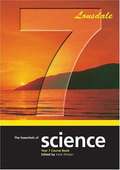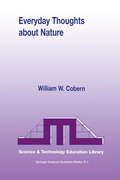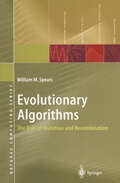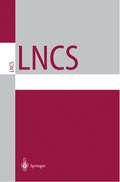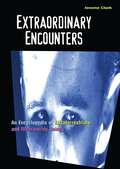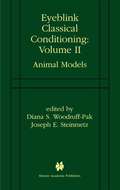- Table View
- List View
The Essentials of Science Year 7 Course Book (PDF)
by Katie WhelanIt exactly matches both the content and the spirit of the exemplar scheme of work for Year 7 produced by the Qualifications and Curriculum Authority. It consists of 12 units in Year 7. Each Unit ensures complete coverage of the revised programme of study. The main keywords are highlighted throughout the text.
Ethnicity in Ghana: The Limits of Invention
by NA NAAlthough African ethnicity has become a highly fertile field of enquiry in recent years, most of the research is concentrated on southern and central Africa, and has passed Ghana by. This volume extends many of the distilled insights, but also modifies them in the light of the Ghanaian evidence. The collection is multidisciplinary in scope and spans the pre-colonial, colonial and post-colonial contexts. A central contention of the volume is that, while there were significant regional variations, ethnicity was not purely a colonial `invention'. The boundaries of `we-groups' have constantly mutated from pre-colonial times, while European categorization owed much to indigenous ways of seeing. The contributors explore the role of European administrators and recruitment officers as well as African cultural brokers in shaping new identities. The interaction of gender and ethnic consciousness is explicitly addressed. The volume also examines the formulation of the national question in Ghana today - in debates over language policy and conflicts over land and chieftaincy.
Europäische Fossillagerstätten
by Giovanni PinnaDieses Buch über europäische Fossillagerstätten richtet sich an eine breite Leserschaft. Es zeigt am Beispiel von 25 bedeutenden Fossillagerstätten anschaulich die geologische, biologische und geographische Entwicklung des europäischen Kontinents auf. In 5 Kapiteln werden alle geologischen Zeitalter vorgestellt. Dieser Band ist das Ergebnis einer internationalen Zusammenarbeit von mehr als 30 renommierten Paläontologen aus 13 verschiedenen europäischen Ländern und wird gefördert von der Europäischen Paläontologischen Gesellschaft.
The European Union and Asean: Trade and Investment Issues
by NA NAIn mid-1997, a major crisis embraced the economies of Southeast Asia. Its effects were severe, particularly on the countries of the Association of Southeast Asian Nations, many of whose currencies suffered market devaluations. This volume addresses the causes of the crisis and its ramifications for both trade and investment between the European Union and ASEAN at the turn of the century.
Everyday Thoughts about Nature: A Worldview Investigation of Important Concepts Students Use to Make Sense of Nature with Specific Attention of Science (Contemporary Trends and Issues in Science Education #9)
by W.W. CobernThe Evolution of The Milky Way (Astrophysics and Space Science Library #255)
by Francesca Matteucci Franco GiovannelliThis review of the most up-to-date observational and theoretical information concerning the chemical evolution of the Milky Way compares the abundances derived from field stars and clusters, giving information on the abundances and dynamics of gas.
Evolutionary Algorithms: The Role of Mutation and Recombination (Natural Computing Series)
by William M. SpearsDespite decades of work in evolutionary algorithms, there remains an uncertainty as to the relative benefits and detriments of using recombination or mutation. This book provides a characterization of the roles that recombination and mutation play in evolutionary algorithms. It integrates important prior work and introduces new theoretical techniques for studying evolutionary algorithms. Consequences of the theory are explored and a novel method for comparing search and optimization algorithms is introduced. The focus allows the book to bridge multiple communities, including evolutionary biologists and population geneticists.
Evolutionary Biology: Limits to Knowledge in Evolutionary Genetics (Evolutionary Biology #32)
by Michael T. Clegg Max K. Hecht Ross J. MacIntyreAfter volume 33, this book series was replaced by the journal "Evolutionary Biology." Please visit www.springer.com/11692 for further information. The nature of science is to work on the boundaries between the known and the unknown. These boundaries shift as new methods are developed and as new concepts are elaborated (e.g., the theory of the gene, or more recently, the coalescence framework in population genetics). These tools allow us to address questions that were previously outside the realm of science, and, as a consequence, the boundary between the knowable and unknowable has shifted. A study of limits should reveal and clarify the boundaries and make sharper the set of questions. This book examines and analyzes these new limits as they are applied to evolutionary biology and population genetics. It does this by framing the analysis within four major classes of problems - establishing the fact of evolution; understanding the evolutionary pathways that led to today's biological world; mechanisms of evolutionary change (e.g., models of social behavior, sexual selection, macro evolution); and, finally, prediction.
Evolutionary Biology: Volume 26 (Evolutionary Biology #31)
by Michael T. Clegg Ross J. Macintyre Max K. HechtEvolutionary Biology and Ecology of Ostracoda: Theme 3 of the 13th International Symposium on Ostracoda (ISO97) (Developments in Hydrobiology #148)
by David J. Horne Koen MartensOstracoda (Crustacea) are potentially excellent model organisms for evolutionary studies, because they combine an extensive fossil record with a wide recent distribution and therefore allow studies on both patterns and processes leading to extant diversity. The main scientific domains contributing theories, concepts, and data to evolutionary biology are morphology (including ontogeny), palaeontology, genetics, and ecology, and to all of these aspects ostracods can contribute. This is clearly illustrated by the fifteen papers presented under Theme 3 of the 13th International Symposium on Ostracoda (Chatham, UK) in 1997 which are grouped in the present proceedings, one of three volumes resulting from this meeting. The contributions deal with the evolution of both extant and fossil forms (including most of the Phanaerozoic), ecology of both marine and freshwater taxa, and (developmental) morphology of both soft parts and valves. Although the canvas is wide, each paper clearly shows how studies on Ostracoda can be relevant to general theory on evolutionary biology and ecology.
The Evolutionary Biology Papers of Elie Metchnikoff (Boston Studies in the Philosophy and History of Science #212)
by Alfred I. Tauber Donald I. Williamson HelenaGourkoElie Metchnikoff (1845-1916), winner of the Nobel Prize in 1907 for his contributions to immunology, was first a comparative zoologist, who, working in the wake of Darwin's On the Origin of Species, made seminal contributions to evolutionary biology. His work in comparative embryology is best known in regard to the debates with Ernst Haeckel concerning animal genealogical relationships and the theoretical origins of metazoans. But independent of those polemics, Metchnikoff developed his `phagocytosis theory' of immunity as a result of his early comparative embryology research, and only in examining the full breadth of his work do we appreciate his signal originality. Metchnikoff's scientific papers have remained largely untranslated into English. Assembled here, annotated and edited, are the key evolutionary biology papers dating from Metchnikoff's earliest writings (1865) to the texts of his mature period of the 1890s, which will serve as an invaluable resource for those interested in the historical development of evolutionary biology.
Evolvable Systems: Third International Conference, ICES 2000, Edinburgh, Scotland, UK, April 17-19, 2000 Proceedings (Lecture Notes in Computer Science #1801)
by Julian F. Miller Adrian Thompson Peter Thomson Terence C. FogartyThis book constitutes the refereed proceedings of the Third International Conference on Evolvable Systems: From Biology to Hardware, ICES 2000, held in Edinburgh, Scotland, UK, in April 2000.The 27 revised full papers presented were carefully reviewed and selected for inclusion in the proceedings. Among the topics covered are evaluation of digital systems, evolution of analog systems, embryonic electronics, bio-inspired systems, artificial neural networks, adaptive robotics, adaptive hardware platforms, molecular computing, reconfigurable systems, immune systems, and self-repair.
The Ex Situ Conservation of Plant Genetic Resources
by J.G. Hawkes Nigel Maxted B.V. Ford-LloydIt is a distressing truism that the human race during the last millennium has caused the exponential loss of plant genetic diversity throughout the world. This has had direct and negative economic, political and social consequences for the human race, which at the same time has failed to exploit fully the positive benefits that might result from conserving and exploiting the world's plant genetic resources. However, a strong movement to halt this loss of plant diversity and enhance its utilisation for the benefit of all humanity has been underway since the 1960's (Frankel and Bennett, 1970; Frankel and Hawkes, 1975). This initiative was taken up by the Convention on Biological Diversity (CBD, 1992) that not only expounds the need to conserve biological diversity but links conservation to exploitation and development for the benefit of all. Article 8 of the Convention clearly states the need to develop more effective and efficient guidelines to conserve biological diversity, while Article 9, along with the FAO International Undertaking on Plant Genetic Resources, promotes the adoption of a complementary approach to conservation that incorporates both ex situ and in situ techniques.
Exchange and Transport of Air Pollutants over Complex Terrain and the Sea: Field Measurements and Numerical Modelling; Ship, Ocean Platform and Laboratory Measurements (Transport and Chemical Transformation of Pollutants in the Troposphere #9)
by PeterBorrell FranzFiedler Søren E. LarsenAs the regional models required to understand and control the generation, distribution and deposition of air pollutants become more precise, the need to understand the detailed effects of hilly and mountainous terrain becomes more acute. The Alpine regions and the mountainous Mediterranean coasts have large effets on the way the pollutant burden is spread in their areas. Similarly an understanding of the effects of chemical and physical processes controlling pollutant deposition and the emission of biogenic compounds is essential to the correct modelling of the coastal regions which surround so much of Europe.The results from two projects on these problems are presented in this volume: one involved a series of field campaigns in the Alps and in the Rhine valley, the other involves ships and platforms in the North Sea and also in the Mediterranean.
Existenzgründung und Existenzsicherung: Vom Unternehmenskonzept zum erfolgreichen Unternehmen (VDI-Buch)
by N. Manz E. HeringDie Autoren beschreiben anschaulich und leicht verständlich strukturierte Vorgehensweisen bei der Existenzgründung. Sie vermitteln kaufmännische Grundkenntnisse und leisten Hilfestellung in Finanzierungsfragen.
Experimental Acoustic Inversion Methods for Exploration of the Shallow Water Environment
by M. B. Porter S. M. Jesus J. P. Hermand A. CaitiIn recent years, research on acoustic remote sensing of the ocean has evolved considerably, especially in studying complex physical and biological processes in shallow water environments. To review the state of the art, an international workshop was held at Carvoeiro, Portugal, in March 1999, bringing together leading international researchers in the field. In contrast to much of the recent theoretical work, emphasis was placed on the experimental validation of the techniques. This volume, based on presentations at this workshop, summarizes a range of diverse and innovative applications. The invited contributions explore the use of acoustics to measure bottom properties and morphology, as well as to probe buried objects within the sediment. Within the water column, sound is applied to imaging of oceanographic features such as currents and tides or monitoring of marine life. Another key theme is the use of sound to solve geometric inverse problems for precise tracking of undersea vehicles. Audience: This volume should be useful both to the novice seeking an introduction to the field and to advanced researchers interested in the latest developments in acoustic sensing of the ocean environment. The workshop was sponsored by the Fundação para a Ciêcia e a Tecnologia (Portuguese Foundation for Science and Technology).
Experimentalphysik 3: Atome, Moleküle und Festkörper (Springer-Lehrbuch)
by Wolfgang DemtröderAtome, Moleküle und Festkörper ist der dritte Band des auf vier Bände angelegten Lehrbuches zur Experimentalphysik von Professor Demtröder. Die Lehrinhalte des dritten Semesters Physik werden nach dem Konzept der beiden ersten Bände leicht verständlich und dabei möglichst quantitativ präsentiert. Wichtige Definitionen und Formeln sowie alle Abbildungen und Tabellen wurden zweifarbig gestaltet, um das Wesentliche deutlicher herauszustellen. Durchgerechnete Beispiele im Text sowie Übungsaufgaben nach den Kapiteln mit ausführlichen Lösungen am Ende des Buches helfen dabei, den Stoff zu bewältigen, und regen zu eigener Mitarbeit an. Viele Illustrationen sowie einige Farbtafeln zu ausgesuchten Themen tragen zum Spaß an diesem Buch bei. Die zweite Auflage wurde überarbeitet, aktualisiert und erweitert: Neu hinzugekommen ist ein Kapitel zu optischen Eigenschaften von Festkörpern und zu Oberflächen.
Exploring Cognition: Readings in Cognitive Neuropsychology and Connectionist Modelling
by Gillian Cohen Robert A. Johnston Kim PlunkettExploring Cognition: Damaged Brains and Neural Networks analyses the contribution made by cognitive neuropsychology and connectionist modelling to theoretical explanations of cognitive processes. Bringing together evidence from both damaged brains and neural networks, this exciting and innovative approach leads to re-evaluation of traditional theories: connectionist models lesioned to mimic the residual function of the damaged brain and rehabilitated to simulate the process of recovery suggest underlying mechanisms and challenge previous interpretations.In this reader key articles by leading international researchers are combined with linking commentaries that provide a context, highlight the conceptual themes and evaluate the evidence. Carefully selected to include hotly debated topics, the papers cover, among others, the controversies surrounding explanations for category specificity in object recognition and for covert recognition of faces and words; the mechanisms underlying the use of regular and irregular past tenses; and the reading of regularly and irregularly spelled words. The challenges posed by connectionist models to assumptions about the nature of dissociations, the need for symbolic rule-based operations in language processing and the modularity and localisation of processes are assessed.Exploring Cognition: Damaged Brains and Neural Networks will be of interest to advanced undergraduates, postgraduates and researchers in cognitive neuropsychology and cognitive neuroscience.
Exploring Cognition: Readings in Cognitive Neuropsychology and Connectionist Modelling
by Gillian Cohen Robert A. Johnstone Kim PlunkettExploring Cognition: Damaged Brains and Neural Networks analyses the contribution made by cognitive neuropsychology and connectionist modelling to theoretical explanations of cognitive processes. Bringing together evidence from both damaged brains and neural networks, this exciting and innovative approach leads to re-evaluation of traditional theories: connectionist models lesioned to mimic the residual function of the damaged brain and rehabilitated to simulate the process of recovery suggest underlying mechanisms and challenge previous interpretations.In this reader key articles by leading international researchers are combined with linking commentaries that provide a context, highlight the conceptual themes and evaluate the evidence. Carefully selected to include hotly debated topics, the papers cover, among others, the controversies surrounding explanations for category specificity in object recognition and for covert recognition of faces and words; the mechanisms underlying the use of regular and irregular past tenses; and the reading of regularly and irregularly spelled words. The challenges posed by connectionist models to assumptions about the nature of dissociations, the need for symbolic rule-based operations in language processing and the modularity and localisation of processes are assessed.Exploring Cognition: Damaged Brains and Neural Networks will be of interest to advanced undergraduates, postgraduates and researchers in cognitive neuropsychology and cognitive neuroscience.
Exploring European Frontiers: British Travellers in the Age of Enlightenment
by B. DolanThe explorations of eighteenth-century travellers to the 'European frontiers' were often geared to define the cultural, political, and historical boundaries of 'European civilization.' In an age when political revolutions shocked nations into reassessing what separated the civilised from the barbaric, how did literary travellers contemplate the characteristics of their continental neighbours? Focusing on the writings of British travellers, we see how a new view of Europe was created, one that juxtaposed the customs and living conditions of populations in an attempt to define 'modern' Europe against a 'yet unenlightened' Europe.
Extracellular Matrix Protocols (Methods in Molecular Biology #139)
by Charles H. Streuli and Michael E. GrantIt is now widely accepted that much of the dynamic function of cells and tissues is regulated from outside the cell by the extracellular matrix. In ad- tion to its conventional role in providing a scaffold for building tissues, the extracellular matrix acts as a directional highway for cellular movement and provides instructional information for promoting survival, proliferation, and differentiation. Indeed, the extracellular matrix is beginning to take a starring role in the choreography of cell and tissue function. The diverse roles of the extracellular matrix are reflected in its highly complicated structure, consisting of an ever increasing number of components. Yet the mechanisms of extracellular matrix assembly and how they influences cell behavior are only just beginning to be understood. In order to solve these problems new methodologies are, of necessity, being developed. Many of these technologies are highly sophisticated and are currently available only in a ha- ful of laboratories. However, we believe that they can readily be transported and established by other researchers. Thus, the purpose of Extracellular Matrix Protocols is to present some of these complicated techniques in a style that is relatively easy to reproduce.
Extraordinary Encounters: An Encyclopedia of Extraterrestrials and Otherworldy Beings
by Jerome ClarkHere is the first A–Z encyclopedia to explore the convictions held by many in the modern day world that extraterrestrials, angels, fairy-folk, and other-dimensional intelligences regularly interact with human beings.Extraordinary Encounters: An Encyclopedia of Extraterrestrials and Otherworldly Beings is the first ever illustrated A–Z encyclopedia to explore these fascinating modern day beliefs, personalities, beings, and events. Among the beings you'll meet in its pages are Abraham, a collection of highly evolved entities that speak in one voice; Metranon, the divine interface between God and the Outer Worlds (and sometime Old Testament angel); and The Planetary Council, whose members include Jove, Merlin, Quetzalcoatl, and Lao-Tzu.
Eyeblink Classical Conditioning Volume 2: Animal Models
by Diana S. Woodruff-PakClassical conditioning of the nictitating membrane (NM) eyeblink response in rabbits is a useful model system for the study of the neurobiology of learning and memory. This paradigm that is so well described on a biological level has also been applied to studies of normal development over the life span and to instances of abnormal developmental phenomena. Eyeblink conditioning has been studied from molecular and neural network perspectives, and the paradigm is of demonstrated utility in elucidating mechanisms in physiology and pharmacology. This model system provides a behavioral paradigm in animals that has a close analog in human behavior. Perspectives of recent developments in human eyeblink classical conditioning research are presented in the companion volume to this book, Eyeblink Classical Conditioning: Applications in Humans.
Feedback Control Systems: A Fast-Track Guide for Scientists and Engineers
by Alex Abramovici Jake ChapskyFeedback Control Systems: A Fast Track Guide for Scientists and Engineers is an essential reference tool for: Electrical, mechanical and aerospace engineers who are developing or improving products, with a need to use feedback control systems. Faculty and graduate students in the fields of engineering and experimental science (e.g., physics) who are building their own high-performance measuring/test arrangements. Faculties teaching laboratory courses in engineering and measurement techniques, and the students taking those courses. Practising engineers, scientists, and students who need a quick intuitive education in the issues related to feedback control systems. Key features of Feedback Control Systems: The contents and the layout of the book are structured to ensure satisfactory proficiency for the novice designer. The authors provide the reader with a simple yet powerful method for designing control systems using several sensors or actuators. It offers a comprehensive control system troubleshooting and performance testing guide. From the reviewers: Control systems are ubiquitous and their use would be even more widespread if more people were competent in designing them. This book will play a valuable role in expanding the cadre of competent designers. This is a book that needed to be written, and its presentation is different from any other book on controls intended for a wide community of engineers and scientists. The book breaks the common cliché of style in the control literature that tends toward mathematical formality. Instead, the emphasis is on intuition and practical advice. The book contains a very valuable and novel heuristic treatment of the subject. .. one of the best examples of a book that describes the design cycle. The book will help satisfy the demand among practising engineers for a good introduction to control systems.
FEM: Grundlagen und Anwendungen der Finite-Elemente-Methode (Studium Technik)
by Bernd KleinDie CAE-Technik als integratives Verfahren zum Konstruieren und Berechnen verändert derzeit die Arbeitsweise der Ingenieure. Als universelles Lösungsverfahren hat sich die Finite-Elemente-Methode bewährt, die in der Elastostatik, Elastodynamik, Wärmeleitung und Strömungsmechanik anwendbar ist.
